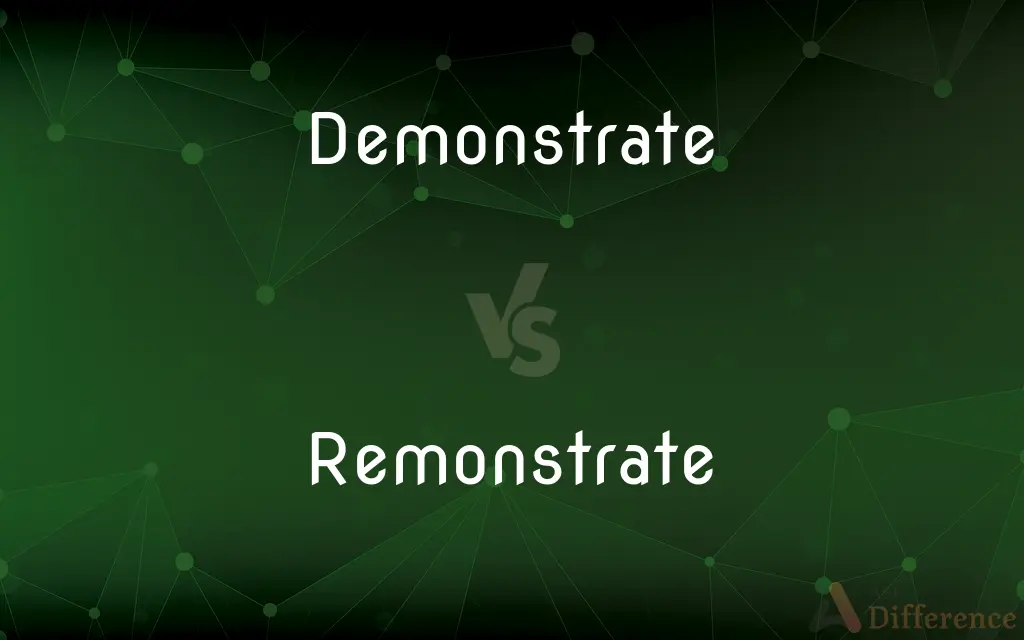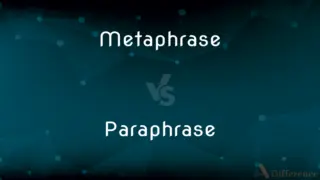Demonstrate vs. Remonstrate — What's the Difference?
Edited by Tayyaba Rehman — By Urooj Arif — Updated on April 30, 2024
"Demonstrate" means to show or prove something clearly through evidence or argument, while "remonstrate" means to protest or complain about something forcefully.

Difference Between Demonstrate and Remonstrate
Table of Contents
ADVERTISEMENT
Key Differences
"Demonstrate" involves showing how something works or proving a point with evidence or examples, making concepts clearer or confirming ideas. Conversely, "remonstrate" is about expressing strong disapproval or objections, often in a formal or vehement manner.
When people demonstrate, they might use physical examples, visual aids, or logical reasoning to make their point, which is generally aimed at educating or persuading. On the other hand, when people remonstrate, they are usually responding to a decision or action they find disagreeable, using argumentation to demand change or reconsideration.
"Demonstrate" can be used in a variety of contexts, from academic demonstrations of scientific principles to public protests where participants demonstrate against policies. In contrast, "remonstrate" is typically used in contexts involving grievances or disputes, where individuals or groups express their dissatisfaction or opposition.
The tone of "demonstrate" is typically neutral or constructive, aimed at instruction or clarification. Whereas the tone of "remonstrate" is often confrontational or adversarial, reflecting conflict or contention.
While demonstrations can be either public or private and often involve a practical display or explanation, remonstrations are primarily verbal and directed at specific parties, typically authority figures or institutions, emphasizing a demand for change or correction.
ADVERTISEMENT
Comparison Chart
Definition
Show or prove by reasoning or evidence
Protest against something forcefully
Usage Context
Educational, persuasive
Disputative, corrective
Communication Style
Explanatory, instructive
Confrontational, critical
Tone
Neutral, constructive
Adversarial, confrontational
Typical Settings
Academia, protests, presentations
Debates, objections, grievances
Compare with Definitions
Demonstrate
Make a public display.
They demonstrated for climate action in the city center.
Remonstrate
Argue against something.
She remonstrated the proposal with well-founded arguments.
Demonstrate
Show by example.
She demonstrated the software's capabilities during the workshop.
Remonstrate
Express disapproval.
He remonstrated with the officials over the decision.
Demonstrate
Prove with evidence.
He demonstrated his point with statistics from recent studies.
Remonstrate
Protest strongly.
They remonstrated against the unfair policies.
Demonstrate
Teach by showing.
The chef demonstrated how to prepare the dish on live television.
Remonstrate
Complain vehemently.
Residents remonstrated the noise pollution in their neighborhood.
Demonstrate
Illustrate a concept.
The scientist used models to demonstrate the theory.
Remonstrate
Challenge or oppose.
The lawyer remonstrated the terms of the agreement during the meeting.
Demonstrate
To show clearly and deliberately; manifest
Demonstrated her skill as a gymnast.
Demonstrate affection by hugging.
Remonstrate
To say or plead in protest, objection, or reproof.
Demonstrate
To show to be true by reasoning or adducing evidence; prove
Demonstrate a proposition.
Remonstrate
To reason or plead in protest; present an objection.
Demonstrate
To present by experiments, examples, or practical application; explain and illustrate
Demonstrated the laws of physics with laboratory equipment.
Remonstrate
(intransitive) To object with in critical fashion; to express disapproval (with, against).
Demonstrate
To show the use of (an article) to a prospective buyer
The salesperson plugged in and demonstrated the vacuum cleaner.
Remonstrate
Specifically, to lodge an official objection (especially by means of a remonstrance) with a monarch or other ruling body.
Demonstrate
To give a demonstration
Described the dance step, then took a partner and demonstrated.
Remonstrate
To state or plead as an objection, formal protest, or expression of disapproval.
Demonstrate
To participate in a public display of opinion
Demonstrated against tax hikes.
Remonstrate
To point out; to show clearly; to make plain or manifest; hence, to prove; to demonstrate.
Demonstrate
(transitive) to show how to use (something).
Can you demonstrate the new tools for us?
Remonstrate
To point out; to show clearly; to make plain or manifest; hence, to prove; to demonstrate.
I will remonstrate to you the third door.
Demonstrate
To show the steps taken to create a logical argument or equation.
Remonstrate
To present and urge reasons in opposition to an act, measure, or any course of proceedings; to expostulate; as, to remonstrate with a person regarding his habits; to remonstrate against proposed taxation.
It is proper business of a divine to state cases of conscience, and to remonstrate against any growing corruptions in practice, and especially in principles.
Demonstrate
(intransitive) to participate in or organize a demonstration.
Those people outside are demonstrating against the election results.
Remonstrate
Argue in protest or opposition
Demonstrate
(transitive) to show, display, or present; to prove or make evident
Remonstrate
Present and urge reasons in opposition
Demonstrate
To point out; to show; to exhibit; to make evident.
Remonstrate
Censure severely or angrily;
The mother scolded the child for entering a stranger's car
The deputy ragged the Prime Minister
The customer dressed down the waiter for bringing cold soup
Demonstrate
To show, or make evident, by reasoning or proof; to prove by deduction; to establish so as to exclude the possibility of doubt or denial.
We can not demonstrate these things so as to show that the contrary often involves a contradiction.
Demonstrate
To exhibit and explain (a dissection or other anatomical preparation).
Demonstrate
Show or demonstrate something to an interested audience;
She shows her dogs frequently
We will demo the new software in Washington
Demonstrate
Establish the validity of something, as by an example, explanation or experiment;
The experiment demonstrated the instability of the compound
The mathematician showed the validity of the conjecture
Demonstrate
Provide evidence for; stand as proof of; show by one's behavior, attitude, or external attributes;
His high fever attested to his illness
The buildings in Rome manifest a high level of architectural sophistication
This decision demonstrates his sense of fairness
Demonstrate
March in protest; take part in a demonstration;
Thousands demonstrated against globalization during the meeting of the most powerful economic nations in Seattle
Common Curiosities
What is the purpose of remonstrating?
The purpose of remonstrating is to express strong protest or objection against something.
Is "remonstrate" always negative?
Remonstrate typically has a negative connotation as it involves opposition or protest.
What skills are necessary to effectively demonstrate something?
Effective demonstration requires clarity, knowledge of the subject, and the ability to engage an audience.
Can "demonstrate" involve physical actions?
Yes, demonstrating can involve physical actions, especially when showing how something works.
Can "demonstrate" be used in a legal context?
Yes, "demonstrate" can be used in a legal context to present evidence or prove a case.
What does it mean to demonstrate something?
Demonstrating involves showing how something works or proving a point through evidence.
How are "demonstrate" and "remonstrate" used differently in language?
"Demonstrate" is used to show or prove something, while "remonstrate" is used to express disagreement or protest.
Is remonstrating effective in changing policies?
Remonstrating can be effective in policy change if it brings significant attention to issues and is backed by strong arguments.
What are the implications of remonstrating in a workplace?
Remonstrating in a workplace can lead to changes if done constructively, but might cause conflict if perceived as aggressive.
Are demonstrations always peaceful?
Demonstrations aim to be peaceful, but can sometimes escalate depending on the context and reactions.
Share Your Discovery

Previous Comparison
Orchard vs. Vineyard
Next Comparison
Metaphrase vs. ParaphraseAuthor Spotlight
Written by
Urooj ArifUrooj is a skilled content writer at Ask Difference, known for her exceptional ability to simplify complex topics into engaging and informative content. With a passion for research and a flair for clear, concise writing, she consistently delivers articles that resonate with our diverse audience.
Edited by
Tayyaba RehmanTayyaba Rehman is a distinguished writer, currently serving as a primary contributor to askdifference.com. As a researcher in semantics and etymology, Tayyaba's passion for the complexity of languages and their distinctions has found a perfect home on the platform. Tayyaba delves into the intricacies of language, distinguishing between commonly confused words and phrases, thereby providing clarity for readers worldwide.
















































